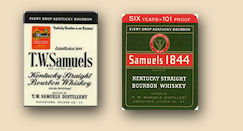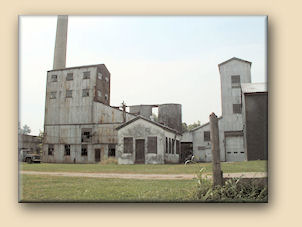American Spirits
GHOSTS
of
WHISKIES
PAST
 T. W. Samuels Deatsville ~ September 2003 |
The distillery known as "T. W. Samuels & Son" date from as far back as 1844, when Taylor William Samuels, with his son W. I., built the distillery on their farm just off Deatsville-Lenore Road, now Kentucky Route 523, approximately one mile south of Deatsville.
They operated the distillery for over fifty years, but unfortunately, both Taylor and his son died in 1898. W. I. Samuels' son, Leslie, became the manager of the distillery at that time.
In the late 1800s and early 1900s, a lot of successful small, local distilleries were attractive to larger concerns, i.e. trusts, that sometimes went to extremes in their endeavor to acquire them. In 1909, a fire destroyed the Samuels distillery, along with six warehouses filled with 9,000 barrels of whiskey, basically the entire stock of the T.W. Samuels and Old Deatsville brands. Shortly afterward -- VERY shortly afterward -- controlling interest was taken over by the Starr Distilling company of Cincinnati and the distillery was rebuilt. Leslie B. Samuels remained as part-owner and manager until the entire operation was closed as a result of Prohibition in 1920. During that time most of the distillery was salvaged and demolished.
In 1933, the
distillery company was reorganized, with Leslie Samuels entering into an
agreement with Robert L. Block of Cincinnati, where Block would become
president, Leslie's father T. W. Samuels would be vice-president, and Les
himself would become the distillery manager. Les' own son Bill became manager
after graduating from the Speed engineering school. Bill would eventually become
the founder of Maker's Mark distillery, near Loretto.
Click
on this photo to see more photos of the T. W. Samuels Distillery
Click here to return to Maker's Mark
Click here for more Ghosts of Whiskies Past
That is not the distillery whose remains we are visiting today, however. Not long after the new company was formed, construction began on a new distillery complex with access to the L&N railroad's Bardstown-Springfield branch. The new distillery had a 600-bushel per day capacity and warehouses capable of storing 19,000 barrels of whiskey
In 1936, when Leslie B. Samuels died, his son, T. W. Samuels (Bill, Sr.) took on the position of manager. He was trained as an engineer, neither a distiller nor a businessman, but he soon learned how to do both jobs quite well. They had basically two brands, "T. W. Samuels" Bottled-in-Bond, with a black label, and a 90-proof version using a similar label, but with a red background.
Both brands developed a strong following, especially in Cincinnati, Texas, and the west coast. It was, in fact, so successful that they had to purchase additional whiskey to meet their sales commitments. Mostly they did this from the Labrot & Graham distillery in Woodford county, until the Brown-Forman company (suffering from the same supply problems) purchased it in 1940.
In 1943, Block wanted to sell the distillery, but Bill Samuels did not. It was only after all attempts to secure financing had failed that Samuels had to acquiesce and allow the family distillery to pass into other hands. The distillery was sold to Foster Trading Corporation of New York, who changed its name to Country Distillers, thus eliminating any trace of the Samuels family from either the facility or the product. It was during this time that Bill Samuels disassociated himself with the company, and it was this company (and probably not his father, as the "official" story goes) from which he vowed to distance himself and the level of quality that he wished to offer his customers. Ten years later he purchased the former Burks Spring Distillery near Loretto and created the Maker's Mark brand
In the early 1950s, the company made some changes to their production methods that had the advantage of increasing production substantially. However, it was said to have created a "burned" taste and smell. After the whiskey was released to the market in 1950-51, sales declined drastically, enough so that distillery actually stopped producing whiskey in 1952. It may have been that bourbon's reputation (although it was no longer called "Samuels") that Bill Samuels was referring to when he spoke of how awful "the old family recipe" was.
As we visit the site today, the old distillery buildings still stand, but they are completely caved in. There are nine warehouses standing, and all are in use: two by Maker's Mark and the other seven by Heaven Hill. For awhile, there was a brand of bottled spring water -- with a label nearly identical the old T. W. Samuels label -- produced here, but even that seems to have closed. We would love to get hold of a bottle or two of the spring water.
Click here to return to Maker's Mark
Click here for more Ghosts of Whiskies Past
|
||||||
|
|
||||||



